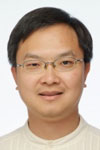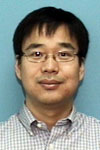Speakers
- Limsoon WONG (NUS, Singapore)
| |
Consistency and Comprehensiveness of Pathway Databases |
 |
It is often necessary to analyze microarray experiments together with biological information to make better biological inferences. We investigate the adequacy of current biological databases to address this need. We find a low level of consistency, comprehensiveness and compatibility among three popular pathway databases (KEGG, Ingenuity and Wikipathways). The level of consistency for genes in similar pathways across databases ranges from 0% to 88%. The corresponding level of consistency for interacting genes pairs is 0%-61%. These three original sources can be assumed to be reliable in the sense that the interacting gene pairs reported in them are correct because they are curated. However, the lack of concordance between these databases suggests each source has missed out many genes and interacting gene pairs. This talk presents our analysis as well as interesting technical intricacies in the comparison of pathway data bases. (Joint work with Donny Soh, Difeng Dong, Yike Guo.)
|
| |
Limsoon Wong is Professor and Head of Computer Science and Professor of Pathology at the National University of Singapore. He currently works mostly on knowledge discovery technologies and their application to biomedicine. He has written about 150 research papers, some of which are among the best cited of their respective fields. Limsoon serves on the editorial boards of Information Systems (Elsevier), Journal of Bioinformatics and Computational Biology (ICP), Bioinformatics (OUP), and Drug Discovery Today (Elsevier). He is a scientific advisor to Semantic Discovery Systems (UK), Molecular Connections (India), and CellSafe International (Malaysia).
|
- Kuiyu CHANG (NTU, Singapore)
| |
Sentiment Evolution over Time |
 |
In this talk, we will share some preliminary findings of our current research in the broad area of sentiment analysis.
(1) we describe how both group and individual passive-active linear first/second order models can be used to model and classify the sentiments of a twitter user over time.
(2) we present a two-view Support Vector Machine (SVM) to classify user sentiments using high-level features (view 1) and classical bag-of-word features (view 2).
(3) We introduce a supervised text vector weight model that is tuned by the discriminant capability of each word features
, and show how it achieves better sentiment classification accuracy than classical TFIDF and other class-aware variations. We also derive theoretical bounds to show why it works.
(4) We present preliminary results on a statistically engineered approach to automatically extract important features from Chinese sentiments.
(5) Lastly, if time permits we will show a prototype of our ROSE-Review and Opinion Search Engine.
Work done by
Ph.D. students:Guangxia Li, Thanh Tam NGUYEN, Zhen HAI
Collaborators:Steven C.H. HOI, Ramesh Jain, Siu-Cheung HUI, Qinbao SONG
|
| |
Prior to NTU, Kuiyu was senior risk management analyst for ClearCommerce (now eFunds). From 2000 to 2002 he was a member of technical staff at Interwoven (now Autonomy). He has served as program co-chair for PAISI (2006-2008), and publications chair for PAKDD 2006. Kuiyu is recipient of two best paper awards (IEEE/ISI 2005, Motorola 1996). Kuiyu consults regularly for IT companies in China and Singapore.
|
- Daniel RACOCEANU (NUS, Singapore)
| |
MICO – A Cognitive Virtual Microscopic Platform for Histopathological Whole Slide Images Analysis: Application to Breast Cancer Grading |
 |
Histopathological examination is a powerful method for prognosis of major diseases. Despite significant advances in fast scanning and acquisition/exploration capabilities, analysis and grading of Whole Slide Images largely remains the work of human experts. The COgnitive virtual MIcroscope - MICO - constitutes an original platform in which visual reasoning, semantic indexing, specific medical ontologies and multi-scale computer vision algorithms are integrated in a seamless, interactive and user-confluent way. Built on a generic modular structure, a computer vision module includes high and low resolution image analysis within a multi-scale fast WSI framework. User interaction is supported by a specialized ontology as well as automatic semantic annotation and content-based image retrieval capabilities with visual reasoning potential.
We validate our system on a computer-aided breast cancer grading (using the Notthingham Grading System) application using histopathology images, in collaboration with Pathologists from the National University Hospital of Singapore, providing the ground truth with local and global annotations for 15 breast cancer slides, corresponding to about 60,000 high magnification (40X) high power fields.
|
| |
Senior Scientist at the French National Research Center (CNRS), Daniel Racoceanu is the Co-Director (France) of Image & Pervasive Access Lab (IPAL), the International Joint Research Unit – (UMI CNRS 2955) created in Singapore between the CNRS, the National University of Singapore (NUS), the Institute for Infocomm Research (I2R) of the Singaporean Agency for Science, Technology and Research (A*STAR) and the University Joseph Fourier, Grenoble, France (UJF). His researches in IPAL focus on Intelligent Diagnosis/Prognosis Assistance using Medical Image and Knowledge-Based Reasoning Systems, Content and Context Based Medical Image Retrieval and Medical Multimedia Fusion. Since November 2009, Daniel he is also Adjunct Associate Professor at the National University of Singapore, School of computing, Department of Computer Science.
|
- Wee Kheng LEOW (NUS, Singapore)
| |
Predictive Simulation of Complex Heart Surgeries |
 |
Cardiac surgery is a very complex procedure due to the complexity of the
human heart and various heart diseases. At present, no convenient computer
tool is available for the surgeons to perform pre-operative planning and
simulation. They often rely on manual drawing to visualize the surgical
procedure and the expected results. This approach is not precise and is
impossible to provide detailed information about the possible outcome of
the surgical procedure.
To improve the precision and effectiveness of cardiac surgical planning,
novel computer simulation systems that perform planning and simulation of
cardiac surgeries are in demand. These systems should be able to help the
surgeons to easily explore various surgical options, predict the surgical
outcomes of different options, accurately evaluate the surgical outcomes
and determine the best surgical options.
Our research goal is to develop a predictive simulation system for cardiac
surgery. This system visualizes 3D models reconstructed from patient's CT/MR
images for the surgeon's reference. Given a small number of user inputs, the
system can predict complex surgical results that involve soft tissues such as
the heart and the blood vessels. With this kind of system, the surgeon does
not have to go through all the surgical steps to see the expected surgical
results. They can easily and efficiently explore various surgical options to
develop a comprehensive surgical plan.
|
| |
Dr. Wee Kheng Leow obtained his B.Sc. and M.Sc. in Computer Science from National University of Singapore in 1985 and 1989 respectively. He pursued Ph.D. study at The University of Texas at Austin and obtained his Ph.D. in Computer Science in 1994. His curent research interests include computer vision, medical image analysis, and protein docking. He has published more than 80 technical papers in journals, conferences, and books. He has also been awarded two U.S. patents and has published another patent under PCT. He has served in the Program Committees and Organizing Committees of various conferences. He has collaborated widely with a large number of local and overseas institutions. His current local collaborators include I2R of A*STAR, Singapore General Hospital, National University Hospital, and National Skin Centre, and overseas collaborators include CNRS in France and National Taiwan University and National Taiwan University Hospital.
|
- Ju Han KIM (SNU, Korea)
| |
Transforming Healthcare through Translational Bioinformatics |
 |
Bioinformatics is a rapidly emerging field of biomedical research. A flood of multi-modal high throughput genomic and post-genomic data means that many of the challenges in biomedical research and healthcare are now challenges in integrative and computational sciences. Postgenome informatics, powered by multi-modal high throughput technologies and genomic-scale databases, is likely to transform our biomedical understanding forever much the same way that biochemistry did a generation ago.
In this talk, I will describe how these technologies and translational bioinformatics will impact biomedical research and clinical practice, introducing recent advances in integrating many different but complementary genomic profiles with the emphasis on the necessity of tight integration of private and public databases and integrative informatics technologies.
I will introduce some of our research efforts for translational bioinformatics approaches. Xperanto (Expressionist's Esperanto in XML) as a part of Bio-EMR system semantically integrates major data models for DNA microarray, tissue microarray and arrayCGH data with extended clinical and histo-pathological information models and analysis tools in an effort to establish a comprehensive knowledge and trial base for translational bioinformatics research. BioEMR is designed to support clinical trial informatics infrastructure and being believe to realized the vision of 'clinical trial as a byproduct of clinical practice'. Each step will be given with real examples from ongoing research activities in the context of clinical relevance.
|
| |
Ju Han Kim, M.D., Ph.D. is currently Professor of Seoul National University
(SNU) College of Medicine. Ju Han Kim obtained his M.D. and Ph.D. degrees from SNU in Seoul,
Korea and completed his residency training in neuro-psychiatry at SNU Hospital in
1996. During his residency program in 1995, Ju Han Kim developed a psychiatric
electronic medical record system, PsyBase, which is currently being used as a part of
integrated clinical information system in SNU Hospital. Through his master’s and Ph.D.
thesis work, he invented a series of novel brain-image pattern-analysis methodologies
by area-preserving topographic transformation studies. He also participated in the
development and management of the Dementia Telemedicine Center (DTC), which
opened in September 1996 at SNU Hospital and provided community-based telepsychiatric
services for the elderly.
|
- Jung-Jae KIM (NTU, Singapore)
| |
Trends in Biomedical Text Mining for Knowledge Discovery |
 |
Automatic literature analysis has been successfully integrated into bioinformatics research and services to promote efficient knowledge discovery. It exploits the biomedical literature as a rich information source reporting on experimental findings and novel hypotheses. Text mining solutions process texts to deliver knowledge in the texts to those in need. In this talk, we focus on three trends in biomedical text mining for knowledge discovery. First, text mining has been used to find answers to questions on hand. With success stories of this approach, we explain the customized integration of text mining modules for specific tasks. Second, a great number of general-purpose services have been developed to help biomedical researchers efficiently explore the perpetually increasing literature, while ordinary biologists are still unaware of most of them. We describe a user-oriented characterization of the services, which may also inspire us to further innovative development in this field. Third, ontologies have been used for semantic representation of text in order to facilitate the integration of text mining results into other bioinformatics resources. We discuss the interoperability of text mining systems.
|
|
| |
Jung-jae Kim is currently an Assistant Professor of the School of Computer Engineering at Nanyang Technological University (NTU) in Singapore. He is a member of Bioinformatics Research Centre and of Centre for Computational Intelligence at NTU. He is an editor of Journal of Biomedical Semantics and a member of the Association for Computational Linguistics. He received his BSc, MS, and PhD in 1998, 2000, and 2006, respectively, from KAIST, South Korea. He has worked as a post-doctoral researcher for the Text Mining group of European Bioinformatics Institute (EBI) from 2006 to 2009.
|
|